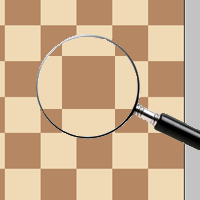
You Have It, He Doesn’t! Part 1
Quite a few amateurs become a bit confused when game annotations talk about the enormous importance of the dark squares in one position or another. Yes, everyone knows what the dark squares are, but in most cases, one is left wondering why they are such a big deal.
Of course, this article isn’t just about the “dark squares.” It’s about gaining something your opponent doesn’t have, and then using it with such energy and finesse that you (metaphorically) shove it down their chessic throat! Thus this article could just as easily have been highlighted by light squares (which does appear at the end of the article!), or a knight versus bishop situation, or any number of other examples that might well be covered in future iterations of this “You Have It, He Doesn’t” theme.
The idea of this theme is simple: In chess you need to create something for yourself and then make use of it. Or, if it’s already there, you need to recognize it (if you don’t know it’s there, you won’t be able to milk it). In the present case, the “something” is the dark squares.
I’ll use two recent tournament examples from my trusty student BB, who somehow continuously gives me extremely instructive games. The lessons here are very, very important, so those that actually want to improve their game should spend a lot of time pondering this article. This kind of information will also help you understand master games, and/or help drive you to the coveted expert (2000) level.
Mejia Luis (1483) – BB (1458), [C12]
Arcadia Chess Club 2014
1.e4 e6 2.d4 d5 3.Nc3 Nf6 4.Bg5 Bb4
The game is a very theoretical French Defense, MacCutcheon Variation.
5.e5 h6
White now has to make a tough decision. The main moves are 6.Bd2 and 6.Be3, but 6.Bh4 g5 7.Bg3 has been tried in recent grandmaster practice, and 6.Bc1 is seen from time to time. The other (obvious) choice, 6.exf6 hxg5 7.fxg7 Rg8 tends to give Black excellent results.
6.Bxf6? gxf6
6.Bxf6 was a poor move that gave Black a “gift.” Most amateurs wouldn’t think much about this so-called gift, but a titled player would instantly have one clear thought: “I have a dark-squared bishop and he doesn’t!”
That one sentence pretty much defines Black’s general strategy: use that dark-squared bishop to dominate the dark squares. No pondering, no calculation, just a clear, obvious path to a happy result. Of course chess is a mix of many things: pattern recognition, willpower, tactical acumen, strategic understanding, etc. You will need to use all these tools if you want to be a successful chess player.
The problem is that most amateurs (beginners and masters alike) don’t have a solid set of positional skills (let alone the whole “package” mentioned above). Thus, in the present case I'll share a truth that defines this article:
If you don't recognize a gift when it's given to you (be it positional or tactical), you won't be able to use it.
That sounds obvious, but it’s actually quite profound, especially in the position after 6...gxf6. Why? Because most players would simply develop their forces without really understanding the cool thing they have. And even if they notice that having the dark-squared bishop is important, they would still be unable to maximize its potential.
If you don't milk a gift's potential, you're missing the boat.

In this kind of position, tactics aren’t going to lead you down the correct path. Doing the, “I’m going to develop my pieces” mantra also isn’t going to help. This is where strategic patterns come into play – they make many positions crystal clear at a glance.
So what is the correct path? The answer is simple: you need to milk your dark-squared bishop by placing your pieces and pawns on squares that compliment it.
This does not mean develop and then see what there is to see! Most of the time people will happily develop their pieces only to discover that it’s hard to find a clear plan or even a good continuation. That’s because you often develop your pieces to squares that actually hurt that early gift (perhaps a file, square, weak pawn, good minor pieces, etc.), or in many cases ignore it.
7.Nf3
I should mention that White is far from dead, but he will need to highlight the plusses in his position too if he wants to go blow for blow with an opponent that’s going to make maximum use of his stuff.
7...Bd7
Playable, but it lacks the desire (or awareness) to make use of that dark-squared bishop (the dark squares are an extension of that bishop, and 7…Bd7 isn’t addressing that – in fact, it’s actually getting in the way of the knight, which would prefer to move to d7). Here’s a perfect illustration of how a top player handles this kind of position:
8.a3
Here Black played 8...Bxc3+ (Playable, of course... Black eventually went on to win the game, even though he got into some trouble). But why not create a puzzle here? Let’s say that after 8...Bxc3+ 9.bxc3 Black played 9...Nc6 (in the game Black played 9...c5), is 10.Bb5 (getting rid of the knight so White’s control over e5 remains firm) a good idea?
Puzzle 1:
Since White was kind enough to give Black the dark-squared bishop on move 6, I would keep the gift with 8...Bf8! when ...c5 will follow (cracking White’s center), and a later ...Bg7 is also in the air, chowing down on the tasty a1-h8 diagonal. Black can castle queenside, or he can safely castle kingside too. In any case, I would be very proud of a student who played 8...Bf8. Here’s a sample line:
Puzzle 2:
Oddly, BB ran into a dark-square situation twice in the same event! In both cases he failed to make use of these “gifts” because he didn’t notice them.
Once again:
If you don't train yourself to notice the many positional gifts you'll be given, you won't be able to play in accordance with the needs of the position.
R. Manahan (1196) – BB (1458) [E94]
Arcadia Chess Club 2014
1.d4 Nf6 2.c4 g6 3.Nc3 Bg7 4.e4 d6 5.Nf3 0-0 6.Be2 e5 7.0-0 Na6 8.Be3 Ng4 9.h3?
9...Nxe3 10.fxe3
Now that you have this position (and the information in our initial example) firmly stuck in your brain, you will no doubt instantly understand what Black should be thinking: “I have a dark-squared bishop, and he doesn’t! How can I make it work for me?”
10...c6
BB said: “Creating space (c7) so the knight can get back into the game and preparing to play ...c5 in case White plays d5.”
Note how BB’s thoughts had nothing to do with his acquisition of the dark-squared bishop. Instead, he wanted to get his knight back into play (a noble idea, but not when Black has far bigger fish to fry).
Though 10...c6 with the idea of ...Nc7 misses the mark, 10...c6 is still in the ballpark since it envisions ...Qb6, hitting b2 and d4 and working the dark squares. Nevertheless, the obvious (and good) move was 10…Bh6, hitting e3 and instantly turning the dark-squared bishop into a very annoying piece.
Before looking at 10...Bh6, there is a very tempting alternative. See if you can find it in the following puzzle.
Puzzle 3:
Let’s return to the position after 10...Bh6:
White has:
* 11.Qd3 Nb4.
* 11.Qd2 exd4 12.Nxd4 (White’s position is wretched since his doubled isolated pawns rest on an open file, meaning they will be targets for a long time to come) and now 12...c6! (takes the b5 and d5 squares away from White’s c3-knight. The tempting ...Nc5 can be played at any time). 13.Rad1 and now 13...Nc5 is strong (13...Qg5 and 13...Re8 are also perfectly reasonable). 14.b4 Ne6 15.Qd3 Qg5 16.Rf3 Bg7 when White is in real trouble due to possibilities like ...Be5 followed by ...Qh4 and ...Ng5, pummeling White’s weak pawns and weak dark squares along the h2-b8 diagonal.
* 11.Kf2 is best. How would you handle this position?
Puzzle 4:
11.d5
Here Black played the hideous 11...c5? which closes the position (not what you want to do when you have two bishops), takes the c5-square away from the a6-knight, and also misses out on another very important idea (Black won anyway). Instead of 11...c5, what should Black do?
Puzzle 5:
Let’s stay with our theme but turbo-charge it with an example (actually a long puzzle, but the notes will make that puzzle an instructive example) of how Alekhine made use of the dark squares:
Puzzle 6:
Of course, once you get used to dominating a weak square complex, you can use your newfound knowledge to claim all sorts of individual weak squares and, naturally, the light squares too. I’ll end this article with another Alekhine game (this time targeting the light-squares!):

Max Bluemich - Alekhine, [B15]
Krakow1941
1.e4 c6 2.d4 d5 3.Nc3 dxe4 4.Nxe4 Nf6 5.Nxf6+ exf6
An interesting, and quite old, line of the Caro-Kann which I personally used quite often.
6.Bc4 Bd6 7.Qe2+ Be7 8.Nf3 Bg4 9.c3 Nd7 10.0-0 Nb6 11.Bb3 0-0 12.Re1 Bd6 13.Bc2 Bh5
14.Qd3 Bg6 15.Qd1 Bc7 16.Bxg6 hxg6
One of my all-time favorite pawn structures, which I call “The Box.” To me, it’s a thing of beauty!
17.Nd2 f5 18.Nf1 Qh4 19.Qf3 Rfe8 20.g3 Qh3
White’s still okay, but do take note of the various potential light-squared weaknesses on c4, d5, f3, g2, and h3.
21.Bf4 Bxf4 22.Qxf4 Nd5 23.Qf3 Nf6 24.Re3 Rxe3 25.Nxe3 Re8 26.Rd1 Ne4 27.Rd3 Ng5!
This knight strikes out at three different advanced light squares: e4, f3, and h3.
28.Qg2 and here we’ll enjoy one final puzzle.
Puzzle 7:
Not done solving puzzles? Tactics Trainer is waiting!
RELATED STUDY MATERIAL
- Read Silman's article series on Alekhine starting with Alexander Alekhine (Part 1): The Game of Death;
- Watch another student who's given the gift of dark squares in GM Dejan Bojkov's Coach Dejan Explains: Dom Using the Dark Squares!;
- Pounce on the weak dark-squared complex after learning from Chess Mentor;
- Maintain your tactical readiness in our Tactics Trainer;
- Looking for articles with deeper analysis? Try our magazine: The Master's Bulletin.






